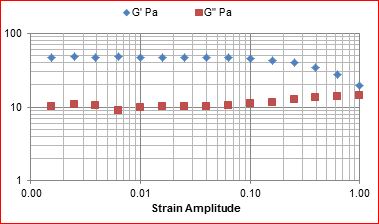
RHEOLOGY TESTING AT FLUID DYNAMICS (908) 200-5823


Copyright 2021. Fluid Dynamics, Inc. All rights reserved.

Constant Frequency
Very important dynamic mechanical measurement and a very useful tool for fluid system characterizations.

An example of an experimental strain sweep at 10 radians/s plotted linear:log. This emulsion has a distinct linear viscoelastic region.. Here we are showing the storage modulus, G’, and loss modulus, G” as a function of strain amplitude.
How strain sensitive is your fluid or soft solid?
Strain sweeps are powerful tool for characterizing fluid systems. Our preference is to work with strain control rheometers, with separate motors and transducers. In these measurements the frequency is fixed and the deformation or strain amplitude is progressively increased. Not only do these measurements identify fluids and soft solids as being linear or non-linear viscoelastic (VE), they also enable yield stresses to be calculated with good reproducibility.
Strain sweeps are typically plotted in log:log graphs as shown above. This can be deceptive and it is useful to plot as linear/logarithmic so see the strain dependence of the Storage Modulus, G’, and Loss Modulus, G’. An example of this is shown in the graph to the left. From these two graphs, one can clearly see that this emulsion is a linear viscoelastic soft body in the strain range selected for this test, obtained at a frequency of 10 radians/s.
These measurements can be used to estimate yield stresses. Our preference is to work with strain controlled instruments.


Things to remember in measuring strain sensitivity
In any rheology measurement, especially of structured fluid systems, there are many opportunities for experimental errors Perhaps one of the most serious is slip at the wall. There are many causes of slip at the wall but if you have it, you need to resolve it quickly - and certainly before any measurements can be made.
Made certain for viscous fluids that the torque upper limit will not be exceeded and check for reproducibility. Always check for reproducibility, especially for structured fluid systems.
Edge effects need to be completed eliminated during measurements. Even if you don’t think your sample is “drying” or ”hardening”, protect those exposed surfaces with a vapor trap or coat/spray/mist edge with inocuous oil coating. Edge effects can be as serious as slip at the wall.
Elastic vs viscous behavior
Where is your material on the VE spectrum? And how does this influence how your product looks and feels?



Slip at the wall?
Torque values?
Reproducibility?
Edge effects?










